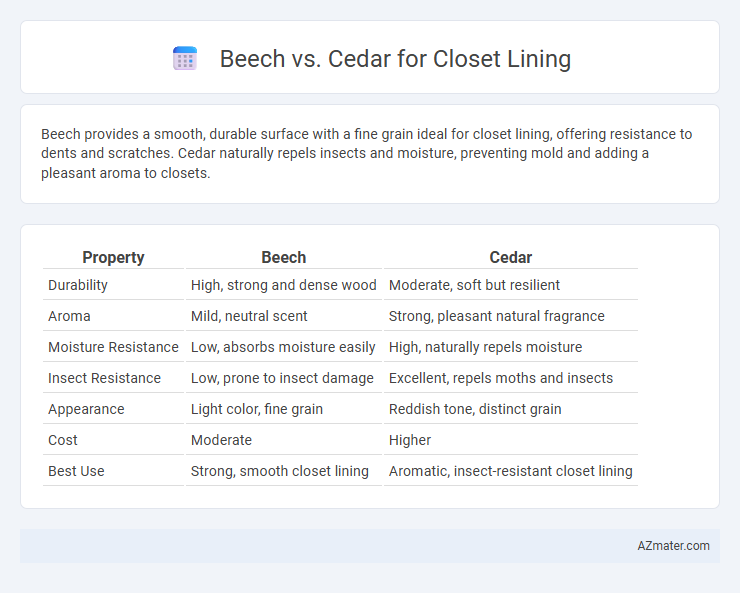Beech provides a smooth, durable surface with a fine grain ideal for closet lining, offering resistance to dents and scratches. Cedar naturally repels insects and moisture, preventing mold and adding a pleasant aroma to closets.
Table of Comparison
| Property | Beech | Cedar |
|---|---|---|
| Durability | High, strong and dense wood | Moderate, soft but resilient |
| Aroma | Mild, neutral scent | Strong, pleasant natural fragrance |
| Moisture Resistance | Low, absorbs moisture easily | High, naturally repels moisture |
| Insect Resistance | Low, prone to insect damage | Excellent, repels moths and insects |
| Appearance | Light color, fine grain | Reddish tone, distinct grain |
| Cost | Moderate | Higher |
| Best Use | Strong, smooth closet lining | Aromatic, insect-resistant closet lining |
Introduction to Closet Lining Materials
Beech and cedar are popular wood choices for closet linings due to their durability and pleasant aromas. Beech offers a smooth, hard surface that resists dents and stains, making it ideal for long-lasting closet interiors. Cedar naturally repels moths and moisture, helping to protect clothing from damage and odors while adding a warm, reddish hue to the space.
Overview of Beech Wood Characteristics
Beech wood is a dense hardwood known for its fine, tight grain and smooth texture, making it an excellent choice for closet lining. Its light color ranges from pale cream to pinkish-brown, providing a clean and bright appearance that enhances closet aesthetics. The wood's durability and resistance to warping ensure long-lasting performance in high-humidity environments commonly found in closets.
Overview of Cedar Wood Characteristics
Cedar wood is highly favored for closet lining due to its natural aromatic scent, which repels moths and insects, helping to protect clothing. Its rich reddish hue and fine grain pattern provide an attractive and warm appearance while also offering natural resistance to moisture and decay. Cedar's durability and ability to absorb excess humidity make it an ideal choice for maintaining a fresh and dry closet environment.
Durability Comparison: Beech vs Cedar
Beech offers superior hardness and resistance to dents, making it highly durable for closet lining in high-traffic areas. Cedar provides excellent natural resistance to moisture, decay, and insects, contributing to long-lasting protection and odor control. While beech excels in resisting physical wear, cedar's durability is enhanced by its aromatic oils that deter pests and resist humidity.
Scent and Aromatic Benefits
Beech wood offers a light, subtle scent that is generally mild and non-intrusive, making it ideal for closet lining where a neutral aroma is preferred. Cedar wood provides a strong, distinctive fragrance known for its aromatic properties that repel moths and insects, helping to protect clothing from damage and odor buildup. The natural oils in cedar contribute to its lasting scent and antibacterial qualities, enhancing closet freshness and garment preservation over time.
Natural Resistance to Pests and Mold
Beech wood offers moderate natural resistance to pests and mold due to its tight grain structure, making it a durable choice for closet lining. Cedar, particularly Western Red Cedar, contains natural oils and compounds that provide superior resistance to insects and fungal growth, making it highly effective for maintaining a fresh, pest-free environment. The aromatic properties of cedar also contribute to repelling moths and other closet pests without the need for chemical treatments.
Aesthetic Appeal and Color Differences
Beech wood offers a smooth, pale cream to light reddish-brown tone with a fine, uniform grain, creating a clean and modern aesthetic ideal for minimalist closet designs. Cedar provides a rich reddish hue that deepens over time, featuring distinct aromatic properties and a natural grain pattern that adds warmth and rustic charm to closet interiors. The color stability of beech contrasts with cedar's evolving patina, making beech better suited for bright, neutral spaces and cedar preferred for cozy, traditional atmospheres.
Maintenance and Longevity
Beech wood offers a smooth, dense grain that requires minimal maintenance and is resistant to wear, making it ideal for closet lining with long-lasting durability. Cedar naturally repels insects and moisture, reducing the need for chemical treatments while maintaining its structural integrity over time. Both woods provide longevity, but cedar's aromatic qualities and natural resistance enhance its performance in humid environments.
Environmental Impact and Sustainability
Beech wood is sourced from fast-growing deciduous trees, making it a more sustainable option for closet lining due to its quicker regeneration rate and lower carbon footprint compared to cedar. Cedar, valued for its natural resistance to pests and moisture, often comes from slower-growing coniferous species, which can raise concerns about deforestation and habitat loss if not harvested responsibly. Choosing FSC-certified beech or cedar ensures responsible forestry practices that mitigate environmental impact and support long-term sustainability.
Cost Considerations and Final Recommendations
Beech offers a moderately priced option for closet lining, balancing durability and aesthetics with a smooth grain that resists wear over time. Cedar typically costs more upfront but provides superior natural resistance to moisture, insects, and odors, making it ideal for long-term closet protection. For budget-conscious projects prioritizing longevity and natural preservation, cedar is recommended, while beech suits those seeking an affordable, attractive finish with reasonable durability.

Infographic: Beech vs Cedar for Closet Lining
 azmater.com
azmater.com